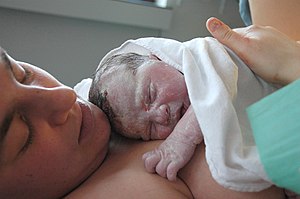physiological process of expelling a fetus from the pregnant human mother's uterus From Wikipedia, the free encyclopedia
Childbirth, also known as labour and delivery, is the ending of pregnancy where one or more babies leaves the uterus by passing through the vagina or by Caesarean section.[4] In 2015, there were about 135 million births globally.[5]
| Childbirth | |
|---|---|
| Other names | Labour and delivery, labor and delivery, partus, giving birth, parturition, birth, confinement[1][2] |
 | |
| Newborn baby and mother | |
| Medical specialty | Obstetrics, midwifery |
| Complications | Obstructed labour, postpartum bleeding, eclampsia, postpartum infection, birth asphyxia, neonatal hypothermia[3] |
| Types | Vaginal delivery, C-section[4] |
| Causes | Pregnancy |
| Prevention | Birth control, abortion |
| Frequency | 135 million (2015)[5] |
| Deaths | 500,000 maternal deaths a year |
About 15 million were born before 37 weeks of gestation,[6] called a premature birth, while between 3 and 12 percent were born after 42 weeks[7] as a postterm delivery.
Birth rate is important in determining the population growth rate.
Seamless Wikipedia browsing. On steroids.
Every time you click a link to Wikipedia, Wiktionary or Wikiquote in your browser's search results, it will show the modern Wikiwand interface.
Wikiwand extension is a five stars, simple, with minimum permission required to keep your browsing private, safe and transparent.